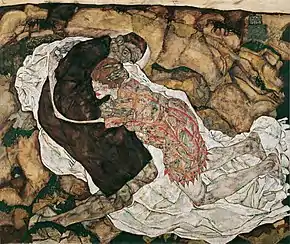
Death and the Maiden (Der Tod und das Mädchen in German) was a common motif in Renaissance art, especially in German painting and printmaking. The usual form shows just two figures, with a young woman being seized by a personification of Death, often shown as a skeleton. Variants may include other figures. It developed from the Danse Macabre with an added erotic subtext. The German artist Hans Baldung depicted it several times.[1]
The motif was revived during the romantic era in the arts, a notable example being Franz Schubert's song "Der Tod und das Mädchen", setting a poem by the German poet Matthias Claudius. Part of the piano part was re-used in Schubert's famous String Quartet No. 14, which is therefore also known by this title, in either English or German.[1]
Selected versions
- Painting: Death and the Maiden (Der Tod und das Mädchen) by Hans Baldung (1517)
- Painting: Death and the Maiden (Der Tod und das Mädchen) by Niklaus Manuel Deutsch I (1517)
- Painting: Young Woman and Death (La jeune fille et la mort) by Henri-Léopold Lévy (1876)
- Engraving: Death and the Maiden (Døden og Piken) by Edvard Munch (1894)
- Painting: Death and the Maiden (Der Tod und das Mädchen) by Adolf Hering (1900) - private collection, location unknown
- Painting: Death and the Maiden by Marianne Stokes (1908)
- Painting: Death and the Maiden (Tod und Mädchen) by Egon Schiele (1915)
- Drawing: Death and the Maiden (Der Tod und das Mädchen) by Clara Siewert (1920s)
- Drawing: Death and the Maiden (Der Tod und das Mädchen) by Joseph Beuys (1959)
- Painting: Death and the Maiden, Ballet for Two by Herbert Lautman (1995)
Gallery
 Hans Burgkmair, Lovers Surprised by Death, 1510. Art Institute of Chicago
Hans Burgkmair, Lovers Surprised by Death, 1510. Art Institute of Chicago Hans Baldung, Death and the Maiden, 1517. Kunstmuseum Basel
Hans Baldung, Death and the Maiden, 1517. Kunstmuseum Basel Chiaroscuro woodcut by Niklaus Manuel Deutsch I, 1517. Kunstmuseum Basel
Chiaroscuro woodcut by Niklaus Manuel Deutsch I, 1517. Kunstmuseum Basel%252C_GDUT10582.jpg.webp) Small engraving by Barthel Beham, 1547
Small engraving by Barthel Beham, 1547 La jeune fille et la mort by Henri-Léopold Lévy, 1876. Museum of Fine Arts of Nancy
La jeune fille et la mort by Henri-Léopold Lévy, 1876. Museum of Fine Arts of Nancy


 Heinrich Hoerle, c. 1919
Heinrich Hoerle, c. 1919 Herbert Lautman, Death and the Maiden, Ballet for Two (1995)
Herbert Lautman, Death and the Maiden, Ballet for Two (1995)
Notes
External links
 Media related to Death and the maiden at Wikimedia Commons
Media related to Death and the maiden at Wikimedia Commons- Death and the Maiden @ La Mort dans l'Art